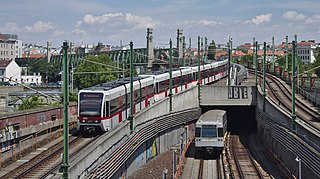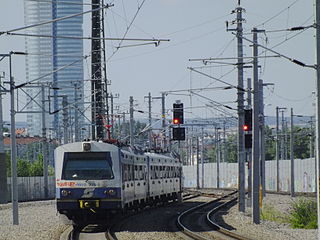
The Vienna U-Bahn, where U-Bahn is an abbreviation of the German word Untergrundbahn, is a rapid transit system serving Vienna, Austria. The five-line network consists of 83.1 kilometers (51.6 mi) of route, serving 109 stations. It is the backbone of what the International Association of Public Transport (UITP) deemed one of the best-performing public transport systems worldwide in 2009. 459.8 million passengers rode the U-Bahn in 2019. The network is undergoing expansion and rolling stock renewal. Since 1969, 200 million euros have been invested annually in the extension of the Vienna U-Bahn.

Wiener Linien is the company running most of the public transit network in the city of Vienna, Austria. It is part of the city corporation Wiener Stadtwerke.

Wien Westbahnhof is a major Austrian railway station, the original starting point of the West railway (Westbahn) and a former terminus of international rail services. In 2015, its role changed with the opening of Vienna's new main station and Westbahnhof is now mainly a commuter station and the terminus of private rail operator WESTbahn's intercity service from Salzburg. Locally, Wien Westbahnhof is served by S-Bahn line S50 and U-Bahn lines U3 and U6. Six tram lines converge on Europaplatz in front of the station, although none go into the city centre. There are also buses to the airport.

The Prater is a large public park in Leopoldstadt, Vienna, Austria. The Wurstelprater, an amusement park that is often simply called "Prater", lies in one corner of the Wiener Prater and includes the Wiener Riesenrad Ferris wheel.

Vienna has an extensive transport system that includes roads, railways, trams, metro, and buses.

The Vienna S-Bahn is a suburban commuter rail network in Vienna, Austria. As opposed to the city-run urban metro network, the Vienna U-Bahn, it extends beyond the borders of the city, is operated by the ÖBB, and consists of many branch lines. S-Bahn is short for Schnellbahn, which can be translated as "rapid railway".

Wien Südbahnhof was Vienna's largest railway terminus. It closed in December 2009 and was demolished in 2010 to be replaced with a new station, Wien Hauptbahnhof. It was located in Favoriten, in the south-east of the city. The East-bound rail services of Südbahnhof remained in operation until 2012 at a temporary train station "Südbahnhof (Ostbahn)".

Wien Franz-Josefs-Bahnhof is a train station in the Alsergrund district of Vienna, Austria. It serves as the southern terminus of the Franz-Josefs-Bahn.

Wien Hauptbahnhof, Vienna Central Station or Vienna Main Station is the main railway station in Vienna, Austria, located in the Favoriten district. It became fully operational in December 2015, linking major railway lines from the north, east, south and west, and replacing the old Wien Südbahnhof terminus. With 268,000 daily commuters it is Austria's busiest long-distance railway station. Aside from being voted "Austria's most beautiful railway station", it was also second in Consumer Choice Center's ranking of "Top 10 Railway Stations for Passenger Convenience in Europe".
Pilgramgasse is a station on the Vienna U-Bahn line U4. It is located in Margareten between Ramperstorffergasse and the eponymous street, which is named after Franz Anton Pilgram (1699–1761), an Austrian Baroque architect. The station is in an open cut parallel to the River Wien and curves to match the curve of the river.

Trams in Vienna are a vital part of the public transport system in Vienna, capital city of Austria. In operation since 1865, with the completion of a 2 km (1.2 mi) route to industrial estates near Simmering, it reached its maximum extent of 292 km (181.4 mi) in 1942. In February 2015, it was the fifth largest tram network in the world, at about 176.9 kilometres (109.9 mi) in total length and 1,071 stations.

Wien Mitte is a rail and U-Bahn station in Vienna, close to the city centre. It is the city terminus of Vienna's City Airport Train (CAT), which provides non-stop service to Vienna International Airport. The station is a major hub for S-Bahn suburban trains, with little service by InterCity trains. The station is connected to the Landstraße U-Bahn station.

Line U1 is a line on the Vienna U-Bahn metro system. Opened in 1978, it currently has 24 stations and a total length of 19.3 km (12.0 mi), from Oberlaa to Leopoldau. When the extension to Oberlaa was completed in 2017, the line became the longest on the network, surpassing the length of U6.

Line U2 is a line on the Vienna U-Bahn metro system. Opened in 1980, it currently has 20 stations and a total length of 16.7 km (10.4 mi), from Karlsplatz to Seestadt. It is connected to U1 at Karlsplatz and Praterstern, U3 at Volkstheater, U4 at Karlsplatz and Schottenring.

Wien Simmering is a railway station located in the Simmering district of Vienna, Austria. Opened in 1976, it is owned and operated by the Austrian Federal Railways (ÖBB), and is served by international, regional and S-Bahn trains.

Wien Hütteldorf is a railway station located in the Penzing district of Vienna, Austria. Opened in 1858, it is owned and operated by the Austrian Federal Railways (ÖBB), and is served by long distance, regional and S-Bahn trains.

Wien Floridsdorf is a railway station located in the Floridsdorf district of Vienna, Austria. Opened in 1961, it is owned and operated by the Austrian Federal Railways (ÖBB), and is served by both regional and S-Bahn trains.

The S1 is a railway service of the Vienna S-Bahn that operates between Marchegg and Wien Meidling. ÖBB operates the service.

The Wien Nordwestbahnhof, abbreviated as Wien NWBH, is a goods station in transformation to a city development area in Brigittenau district of Vienna, Austria. Passenger transport ended in 1959. It serves as the southern terminus of the Austrian Northwestern Railway. The northwestern terminus of the line was Prague Těšnov station till 1972. Freight transport is in the phase of termination. By 2025, a new district will be built on the site. An interim use phase will begin in 2018.
The Vienna semi-metro tramway system was built on separated sections in the 1960s. The underground sections are called Untergrundstrassenbahn or sometimes abbreviated U-Strassenbahn, USTRAB or USTRABA . The semi-metro tunnels are maintained and used by the Wiener Linien, operator of the tramway lines. One section is used as well by the Wiener Lokalbahnen (WLB), the operator of a regional tram-train service.




















